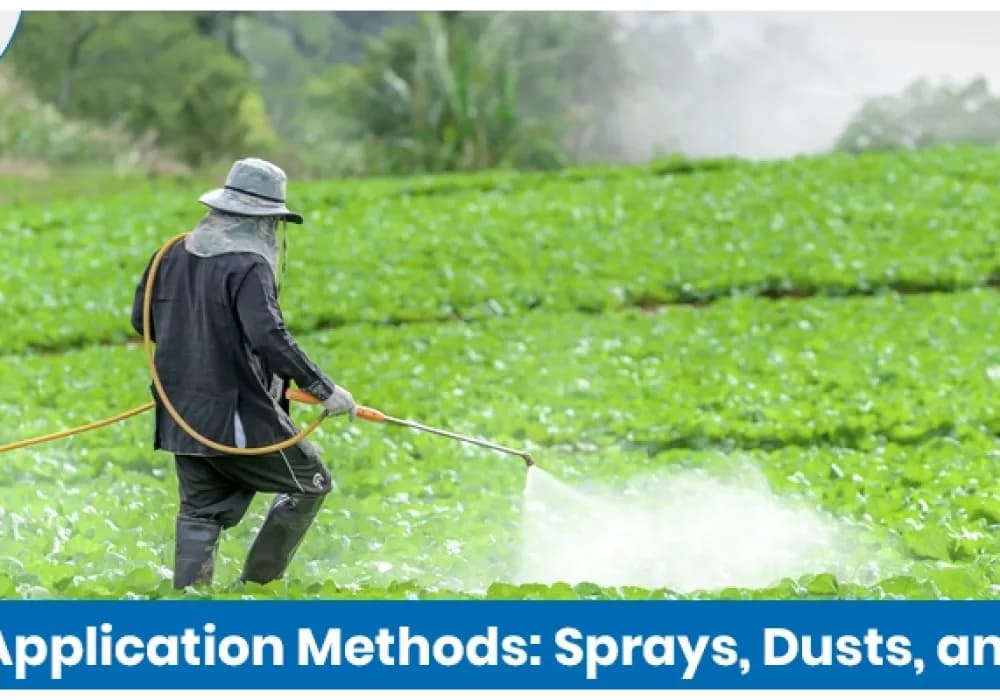Introduction
You have selected the correct fungicide to use on your crop-but are you applying it correctly?
In agriculture, the application of fungicide might prove the difference between success and failure. This should be seen as watering your plants: any water that does not make it to the roots will not be of much use. This is also the case with fungicides.
Appropriate timing and correct use of a spray can put diseases to rest, and improper timings or application can cost you time, money, and even the destruction of crops. That is why it is also highly important to know the correct method of application, as the product is. It aids in enhancing coverage, increasing efficiency, and saving funds, and also promotes secure agriculture.
Overview of Fungicide Application Methods in Indian Farming
In Indian agriculture, it is as important to apply a fungicide properly as to select the most appropriate one. The mode of application varies depending on the crop type, location of the disease, stage of crop development, and the infrastructure available, and includes foliar spraying, soil treatment, seed dressing, and chemigation.
An effective fungicide application strategy enhances disease management, reduces input expenses, and facilitates sustainable agricultural activities within the Integrated Disease Management (IDM).
Factors That Influence Method Selection
The selection of the fungicide application mode is based on several important factors:
Type of Disease:
Leaf diseases, such as blights or rusts, should be treated with foliar spraying, whereas root or collar diseases, such as Fusarium wilt or damping-off, should be treated with soil application or seed treatment.
Type of Crop and Growth Habit:
Tall crops, such as sugarcane or maize, might need high-pressure or drone spraying, and short crops, such as vegetables, can be sprayed through handheld knapsack sprayers.
Accessibility:
Fields that are flooded, such as paddy fields, may be easier to chemigate or spray via aircraft rather than manually spraying.
Economics:
The cost of treating seeds or spraying foliage may be cheaper than other forms of fungicide application, which is why smallholder farmers tend to use such methods. Larger farms can afford to install mechanized or drip-based fungicide delivery systems.
Role of Weather, Crop Stage, and Fungus Type
The application of fungicides is significantly affected by the environmental and biological conditions:
Weather Conditions:
Fungi thrive in high humidity and moderate temperatures (20-30°C). Contact fungicides such as mancozeb may be washed off by rainfall immediately after the spraying, whereas systemic fungicides such as propiconazole are rainfast. To minimize drift and evaporation losses, do not spray on windy days or when it is very hot.
Crop Stage:
At some stages of growth, such as flowering, fruiting, or tillering, the crops are more susceptible to fungal attacks. Sprays just before these stages give optimum protection. As an example, late blight is prevented by the application of metalaxyl + mancozeb during early tuber formation in potatoes.
Fungus Type:
Systemic fungicides are frequently used to combat fast-spreading diseases such as downy mildew and Phytophthora. On the other hand, contact fungicides like sulfur may work well against surface-level illnesses like powdery mildew.
| Application Method | Purpose & Target Area | When to Apply | Common Target Diseases | Example Fungicides | Suitable Crops |
|---|---|---|---|---|---|
| Foliar Application | Sprayed on leaves/stems; targets above-ground infections | During crop growth; early signs or preventive | Leaf spots, blights, rusts, mildews | Propiconazole, Mancozeb, Copper Oxychloride | Wheat, Rice, Grapes, Tomato, Chilli |
| Soil Application | Applied to soil/root zone to kill soil-borne fungi | Before sowing or early crop stages | Root rot, wilt, damping-off | Metalaxyl, Captan, Carbendazim | Banana, Potato, Tomato, Vegetables |
| Seed Treatment | Fungicide-coated seeds to protect from early fungal attacks | Just before sowing | Seed-borne and early soil-borne diseases | Thiram, Tebuconazole, Captan, Carbendazim | Paddy, Wheat, Pulses, Vegetables |
| Other Methods | Chemigation, fumigation, or dusting for special needs | Based on system (pre-sowing/storage/drip) | Downy mildew, storage fungi, field-wide fungal risks | Fosetyl-Al (chemigation), Sulphur (dusting) | Grapes, Onion, Greenhouse crops, Groundnut |
Best Practices for Effective Fungicide Application
To get the maximum benefit from fungicides and reduce waste or crop damage, proper application techniques are essential. The following best practices ensure disease control is timely, targeted, and sustainable under an Integrated Disease Management (IDM) approach.
Dosage Accuracy and Equipment Choice
Proper dosage is vital in disease control and prevention of resistance. Overdosing may damage crops and the environment, and underdosing leads to inadequate control.
Label recommendations should always be followed, and equipment should be calibrated before use. Select sprayers which suit your crop type-knapsack sprayers on vegetables, power sprayers on field crops, and flat-fan nozzles to cover evenly. Properly maintained equipment will provide a more consistent application and increased efficiency of the fungicide.
Timing, Frequency, and Field Preparation
Fungicides work best when used at the correct stage of the crop, normally prior to the disease being present or at initial symptoms. It is frequency-dependent on disease pressure and weather, usually 7-14 days.
The field should be prepared by draining it and clearing the weeds. No spraying in rain or high winds; the best time is early morning or late afternoon to get maximum absorption and minimum evaporation. Effective planning provides good, durable protection against disease.
Conclusion
The knowledge of how and when to apply sprays, dusts, or granules can be the difference between a failing crop and a bumper harvest. Sprays provide quick treatment of diseases that are visible, dusts are convenient during dry weather, and granules are deep in the soil to protect roots.
Both approaches are strong in their own way, but when used in combination with appropriate timing, dosage, and field practices in an IDM strategy, they become effective disease management tools. It is not only to treat the disease; it is to prevent the disease intelligently, save on the cost of input, and save your yield as well as your land. Apply in the best way you can, and don't simply spray with your hands, but with your knowledge.
FAQs

K SANJEEVA REDDY
CHIEF AGRONOMY OFFICER
Sanjeeva Reddy K. serves as the Chief Agronomy Officer at AGRIBEGRI TRADELINK PVT LTD, a role he stepped into in July 2025, where he oversees and manages agronomy expertise across the organization. He holds a Postgraduate degree in Agricultural Science from Tamil Nadu Agricultural University, India, and is a Certified Crop Advisor accredited by the Indian Society of Agri Professionals, in association with the American Society of Agri Professionals. With more than 20 years of experience in crop production, Reddy has built extensive expertise working across reputed agribusiness industries. A significant part of his career includes a decade-long tenure with the internationally recognized Indian brand MULTIPLEX, a leading Bangalore-based manufacturer and marketer of plant nutrients, where he played a key role in driving growth and innovation.
